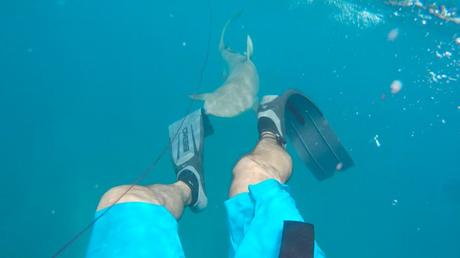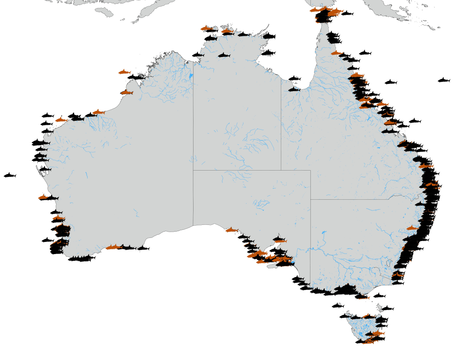Easy. Don’t go swimming/surfing/snorkelling/diving in the ocean.
 “Oh, shit”
“Oh, shit”Sure, that’s true, but if you’re like many Australians, the sea is not just a beautiful thing to look at from the window, it’s a way of life. Trying telling a surfer not to surf, or a diver not to dive. Good luck with that.
A few years ago, I joined a team of super-cool sharkologists led by Charlie ‘Aussie-by-way-of-Belgium shark-scientist extraordinaire‘ Huveneers, and including Maddie ‘Chomp’ Thiele and Lauren ‘Acid’ Meyer — to publish the results of some of the first experimentally tested shark deterrents.
It turns out that many of the deterrents we tested failed to show any reduction in the probability of a shark biting, with only one type of electronic deterrent showing any effect at all (~ 60% reduction).
Great. But what might that mean in terms of how many people could be saved by wearing such electronic deterrents? While the probability of being bitten by a shark is low globally, even in Australia (despite public perceptions), we wondered if the number of lives saved and injuries avoided was substantial.
In a new paper just published today in Royal Society Open Science, we attempt to answer that question.
To predict how many people could avoid shark bites if they were using properly donned electronic deterrents that demonstrate some capacity to dissuade sharks from biting, we examined the century-scale time series of shark bites on humans in Australia. This database — the ‘Australian Shark Attack File‘ — is one of the most comprehensive databases of its kind.

After transforming the data to a per-capita rate, we noted that there seemed to be some long-term oscillations in bite rate that could be explained by long-term climate fluctuations measured by decadal-scale cycles apparent in the southern oscillation index.
Sure enough, there was a long-term (~ multi-decadal) correlation between the southern oscillation index and the bite rate.

We therefore took these oscillating patterns and projected them through to the next half century or so while taking increasing human population size into account (assuming that more people = more bites). This allowed us to tally the number of bites that could be avoided if people who were susceptible to being bitten were wearing good electronic deterrents properly.

We found that if people were wearing electronic deterrents shown to have some capacity at reducing the probability of shark bite, 1000s of people could avoid death and injury over the next half century. This surprised us given the low probability of being bitten (per capita) that exists even today.
When someone gets bitten these days, it’s big news. It also reinforces people’s fear of sharks, and the public pressure to intervene (often fatally). Sharks as a group aren’t doing well around the world, so they don’t need any more bad press. In addition, entire communities can lose millions of dollars in lost tourism revenue following bouts of attacks. Of course, the loss of any life is tragic in its own right.
More importantly, if we can reduce the number of shark bites on people, the incentive to kill ‘problem’ sharks actively (hunting) or passively (mesh nets and drumlines) should reduce. This can only be good news for sharks.
So far, scientific studies demonstrate that electric deterrents are the best at reducing the probability of a shark bite and that many other commercially deterrents do not have any detectable effects on shark behavior. However, not all electric deterrents are equal and the public should ensure that the device they use has been scientifically tested.
CJA Bradshaw

